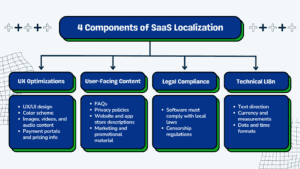SaaS, or Software as a Service, is a way of offering software where a company hosts the applications and lets customers use them over the internet. Instead of buying and installing software the old-fashioned way, users can subscribe and use these applications online. This includes all kinds of software, like tools to help you get work done, manage customer relationships, or other specialized apps.
SaaS localization may appear daunting because of the complexity of localizing things like applications and secure logins. Learn about the basics of SaaS localization and how to overcome the most common pitfalls.
What is SaaS Localization?
SaaS localization is all about adapting your software to fit the needs of multilingual or global markets. This involves updating the way the software looks and works, help guides, and customer support.
The goal is to make sure the software feels right for everyone, no matter where they're using your product. When SaaS companies do this, they create a better experience for their users, making them feel more at home with the product. This not only makes users happier but also helps the company succeed globally.
The Importance of SaaS Localization
As businesses and individuals increasingly rely on cloud-based solutions for their operational needs, the demand for SaaS products has surged across all corners of the globe.
This expansion is not just a testament to the versatility and efficiency of SaaS solutions but also highlights a significant opportunity for SaaS companies to tap into new and emerging markets.
Consider the success of prominent SaaS companies such as Google, Netflix, and Zoom, which have made localization central to their product development. These companies consistently strive to expand their offerings with additional multilingual capabilities, showcasing the significant benefits of embracing localization.
Why Localize Software?
Localization ensures that a product "speaks" the language of its users, both literally and figuratively, making it more accessible and appealing to a global audience. This is not just about translating content into multiple languages but also about adjusting the user interface, payment methods, and support services to align with local preferences and legal requirements.
This attention to detail enhances the overall user experience, making customers more likely to engage with the product and recommend it to others.
Moreover, SaaS localization can substantially increase a company's competitiveness on the global stage. In markets that are often saturated with similar offerings, a localized product can stand out by offering a more personalized and relevant experience to users.
This can be a decisive factor for customers when choosing between different SaaS solutions.
Key Components of SaaS Localization
SaaS localization is crucial for global outreach, involving several key areas to enhance your software’s global appeal.

Why is SaaS Localization So Hard?
Localizing software and SaaS products is extremely complex, and not having a strategic plan can lead to wasted resources and poor outcomes. SaaS applications often have vast amounts of content, including UI text, help documentation, marketing materials, and legal documents.
Collecting and organizing this content for localization can be overwhelming due to its volume, variety, and the technicalities involved in extracting it from the software. Localization is not a one-time task but a continuous process that needs regular updates to stay relevant with your product and target regions.
SaaS localization isn't just about translating words. You have to adjust the technical infrastructure of the software to meet regional requirements for optimal performance.
The architecture of many SaaS applications isn't initially built with localization in mind. Retrofitting or internationalizing a SaaS product for localization can involve significant technical challenges, including internationalizing the codebase so it can handle multiple languages, adjusting layouts to accommodate text expansion or contraction, and ensuring right-to-left (RTL) language support is functional.
Security and Compliance
In software localization, particularly for sensitive sectors like finance and healthcare, security is paramount. This is because localized applications must not only speak to users in their language but also safeguard their sensitive information against breaches and unauthorized access.
For financial applications, where transactions and personal financial data are involved, security measures must ensure encryption, secure data transfer, and compliance with international and local financial regulations. In healthcare applications, patient confidentiality and the protection of personal health information are critical, governed by stringent laws like HIPAA in the United States.
Therefore, during the localization process, it’s essential to incorporate robust security protocols and encryption mechanisms, translating not just the language but also adapting the security measures to the legal and cultural expectations of the target market.
Tools and Technologies for SaaS Localization
When globalizing your SaaS product, leveraging the right tools and technologies is pivotal. These solutions streamline the localization process, ensuring it is both efficient and effective.
Automation Tools
Translation automation in localization can significantly reduce the time and effort needed for repetitive tasks. This includes everything from automatically detecting content changes that need retranslation to generating localized software builds. Translation automation tools can integrate with TMS and CMS platforms, providing a seamless flow of content through the localization pipeline. They ensure that any new or updated content is automatically processed for translation, reviewed, and published without manual intervention.
Choosing the right set of tools is crucial for efficient and effective localization. The best tools are those that integrate well with your existing software stack, support the languages and markets you are targeting, and offer scalability to grow with your business.
They should also provide robust workflow management features to keep your localization process organized and under control. MotionPoint's various localization options easily integrate with any CMS, making the process extremely smooth and pain-free.
Take Your Software Global
For SaaS companies eyeing global expansion, localization should be seen not just as an option but as an integral part of their overarching strategy. The benefits are clear: localized products are more likely to gain traction in new markets, build a loyal user base, and stand out in a competitive digital landscape.
By investing in localization, SaaS businesses open doors to endless opportunities across borders, cultures, and languages.
Última atualização: 27 de março de 2024